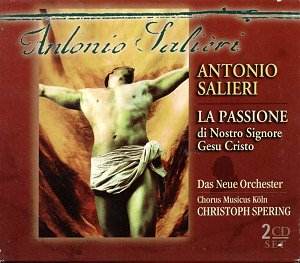First performed at
the Burgtheater in Vienna in 1776 La
passione di nostro Signore Gesu Cristo
is a work of Salieri’s early maturity.
It’s a passion oratorio but one that
gorges on operatic convention to make
its powerfully dramatic points. If it’s
further to be anatomised, the traditional
recitative-aria and solo and chorus
block voicings also faithfully follow
operatic form and so Azione sacra
is as good a term as oratorio to describe
Salieri’s work.
Opening with an enthusiastically
if sometimes approximately played Overture
we immediately face two small recitatives
for Peter followed by his first aria,
Giacché mi tremi in seno,
one that immediately establishes
the dramatic, theatrical direction of
the musical argument, enriched along
the way as it is by colourful accompanying
instrumentation. Maddalena herself is
permitted only one solo – not an aria
as such but a Cavatina (No.8 – Vorrei
dirti il mio dolore) that
follows, almost immediately, the declamatory-consolatory
almost hymnal entreaty of the chorus.
As John, contralto Franziska Gottwald
shows commendable fire and no little
technical address in her early aria
Come a vista – the divisions
are on the button, the voice is flexible
and well supported and she reminds me
just a touch of David Daniels (a high
compliment). I liked Florian Mock’s
Peter and his Part I aria Tu nel
duol felice sei where one finds,
despite some forcing, quite a bit of
colour in the voice. Salieri’s dramatic
instincts are reinforced by his approach
to duet writing – forceful, imaginative,
once more theatrical-operatic – as in
Vi sento, O Dio for Peter and
Maddalena.
Salieri took a text
by Pietro Metastasio written in 1730
which deals with the time after the
crucifixion and burial but which precedes
the resurrection. The libretto balances
the piety of Part I with the yearning
questioning of the nature of the Resurrection
in Part II. And whilst one can’t argue
for the work touching the greatest depths
one can nevertheless find in it a firm
control of schema and of pacing, of
emotive states and of the utilisation
of operatic form for optimum emotive
potential. As a signal of the young
Salieri’s already impressive command
it’s a strong example and this performance,
whilst hardly flawless, is committed
and lucidly performed.
Jonathan Woolf


